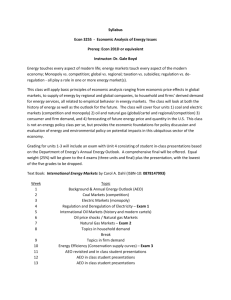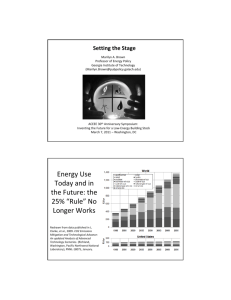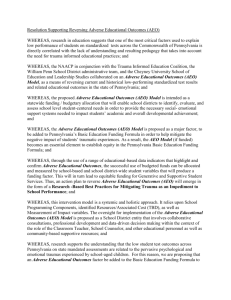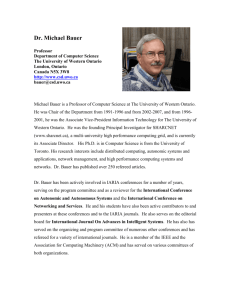DOE All Employees' Meeting
advertisement
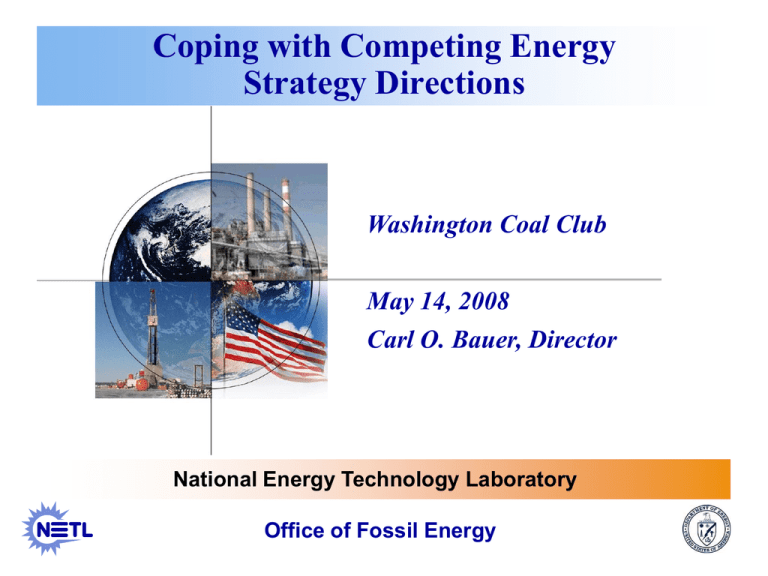
Coping with Competing Energy Strategy Directions Washington Coal Club May 14, 2008 Carl O. Bauer, Director National Energy Technology Laboratory Office of Fossil Energy Energy Demand 2030 Energy Demand Today 118 QBtu / Year 82% Fossil Energy 101 QBtu / Year 85% Fossil Energy + 16% United States 703 QBtu / Year 82% Fossil Energy 453 QBtu / Year 81% Fossil Energy + 55% World Fossil Energy Will Continue to Dominate 2 U.S. data from EIA, Annual Energy Outlook 2008 revision; world data from IEA, World Energy Outlook 2007 C. Bauer, Washington Coal Club, 05/14/08 Energy Strategy Complexity Economic Sustainability Energy Supply Security Aiming for Balanced Solutions Climate Change 3 C. Bauer, Washington Coal Club, 05/14/08 Reserv e margin 25% Reserv e margin 20% Reserv e margin 16% Reserv e margin 8–10% 40,000 2008 2007 2006 2005 2004 2003 2002 2001 2000 1999 1998 1997 1996 1995 1994 1993 1992 1991 1990 20,000 1989 30,000 1988 Peak Demand & Capacity (MW) South African Historical Demand Overview Year Peak Demand Expected Peak Demand Installed Capacity (MW Sent-out) Operational Capacity (MW Sent-out) Reserve Margin Aspiration = 15% 4 “Update on State of Power Security in South Africa”Jacob Marolga, Chief Executive, Eskom, February 19, 2008 C. Bauer, Washington Coal Club, 05/14/08 South African Grid Overwhelmed by Demand 5 The Wall Street Journal, April 17, 2008 C. Bauer, Washington Coal Club, 05/14/08 NERC 2007 Long-Term Reliability Assessment Require 135 GW by 2016 “Areas of the most concern include WECC-Canada, California, Rocky Mountain States, New England, Texas, Southwest, and the Midwest . . .” NERC LTRA 2007 6 NERC 2007 Long-Term Reliability Assessment C. Bauer, Washington Coal Club, 05/14/08 U.S. Peak Summer Generation Capacity NERC and AEO’08 Capacity Outlook 1,400 1,200 +128 GW additional required to maintain capacity margins (NERC) 979 GW +7 GW by 2016 (EIA) G Ws 1,000 800 600 - 41 GW oil and gas steam boilers 400 200 0 20 NE R C New S ummer C apac ity C oal O il and Natural G as S team C ombined C yc le C ombus tion T urbine/Dies el Nuc lear P ower R enewable S ourc es O thers 05 006 007 008 009 010 011 012 013 014 015 016 017 018 019 020 021 022 023 024 025 026 027 028 029 030 2 2 2 2 2 2 2 2 2 2 2 2 2 2 2 2 2 2 2 2 2 2 2 2 2 Capacity Growth Forecasts Vary Substantially Due to Assumptions for Annual Electricity Demand Growth Rates, GDP Growth, and Oil Price 7 EIA, Annual Energy Outlook 2008 revision; NERC 2007 Long-Term Reliability Assessment C. Bauer, Washington Coal Club, 05/14/08 Declining Total Electricity Generation Growth Rate Assumptions 6,000 AEO’05 3.1%/yr GDP growth 5,800 AEO’07 1.5%/yr 5,600 Billion kWh/year NERC growth AEO’06 1.6%/yr 5,400 1.9%/yr growth 5,200 5,000 AEO’08 revision 2.4%/yr GDP growth 4,800 1.1%/yr growth 4,600 4,400 4,200 Reduced 2025 GDP by $2.7 trillion (16%) (2006 dollars) Reduction of 36 BkWh /yr growth equates to reduced need for 4,900 MW of new generation each year (@ 85% c.f.) 4,000 2005 2010 2015 2020 2025 2030 Declining Growth in Long-Term Electricity Demand and U.S. GDP; NERC Estimates Tied to Higher Growth Rate 8 EIA Annual Energy Outlook 2008 revision; NERC 2007 Long-Term Reliability Assessment C. Bauer, Washington Coal Club, 05/14/08 Total Electricity Generation Growth Rates AEO’08 2.2%/yr 20 yr 1.7%/yr 1.5%/yr 6 yr NERC 1.1%/yr EIA Forecast for Electricity Generation Growth Well Below Recent Averages 9 Electricity generation: EIA,19491994: Annual Energy Review 2006; 19952006: Electric Power Annual 2006; 20072030: Annual Energy Outlook 2008 revision; NERC 2007 Long-Term Reliability Assessment C. Bauer, Washington Coal Club, 05/14/08 Net Capacity Changes Removed or Added Opportunities 1st Quarter 2008 95% of MWs removed represent “Announced” projects Removed Capacity Wygen II 90 MW Now Operational Total Net Reductions 614 MW (-0.9%) for 1th Quarter 2008 10 Source: Global Energy Decisions – Velocity Suite (April 2, 2008) C. Bauer, Washington Coal Club, 05/14/08 Coal-Fired Development Activity vs. EIA AEO’08 Trendline ≈ 20 GW through 2016 Low forecasts for new capacity may not reflect sufficient market promise to attract new skilled human resources to the industry AEO’08 reference case 17.9 GW by 2016 Trendline 5-year actual Actual Installation Trend and EIA AEO’08 Reference Forecast Similar; A Significant Surplus of Developments Exists Above EIA’s Forecast Demand 11 EIA, Annual Energy Outlook 2008 revision; Global Energy Decisions – Velocity Suite 12/31/07 C. Bauer, Washington Coal Club, 05/14/08 Can Natural Gas Supply Support a “Dash to Gas”? Total generation AEO’05 Total generation AEO’08 2.3 Tcf Renewable AEO’08 Nuclear AEO’08 Oil and Natural Gas AEO’08 1.4 Tcf Generation from coal if no new plants are built Coal AEO’08 3.7 Tcf of Potential Natural Gas Demand Growth with Declining North American Supply 12 EIA AEO 2008 (rev.) and AEO 2005; Assumes NG-fired combined cycle plants operating at 50% efficiency to fill generation gaps C. Bauer, Washington Coal Club, 05/14/08 Total Natural Gas Supply to United States (Including Liquid Natural Gas) AEO’01 AEO’03 AEO’02 AEO’04 Tcf / Year AEO’05 AEO’06 AEO’07 AEO’08 Gradual Decline to 20 Tcf without LNG AEO’08 no LNG Increased Use of Natural Gas in Electricity Will Require LNG; North American Natural Gas Supply for U.S. Trending Down 13 Annual Energy Outlook 2001, 2002, 2003, 2004, 2005, 2006, 2007 and 2008 March revision reference cases C. Bauer, Washington Coal Club, 05/14/08 Wall Street Journal on LNG (April 18, 2008) “Overall, U.S. imports of LNG have slid over the past nine months to a five-year low, and natural-gas inventories are running relatively low . . . If the U.S. is unable to attract LNG supply this summer, prices could spike up sharply within a few months if a hot summer were to reduce the ability to build a cushion of gas going into next winter.” “Meantime, as Asian buyers grab more LNG from the Atlantic basin, U.S. prices, though at 27-month highs, still look cheap.” 14 Wall Street Journal, Surge in Natural-Gas Price Stoked by New Global Trade, Page1, April 18, 2008 C. Bauer, Washington Coal Club, 05/14/08 $30/t CO2 Tax and $14/MMBtu Natural Gas (Effect on Current Average Generating Costs, by Region) Cost per MWh 13% average$42.84 average 61% average increaseincrease increase $13.15 average increase 249% higher 31% higher increase price increase 148% average increase 148% average $32.73 average increase increase $32.73 average increase Due to Natural Gas Price Impacts, Gas Intensive Regions Will See Higher Real Electricity Cost Impact From Carbon Taxes 15 C. Bauer, Washington Coal Club, 05/14/08 Summary U.S. power generation industry is at a critical juncture, with social pressures and pending legislation demanding massive changes Competing demands for reliable, low-cost energy and climate change mitigation appear incongruent Our Nation’s liquid fuel dependence on foreign resources continues to grow Uncertainty of regulatory outcomes and rising costs impact industry’s willingness to commit capital investment, endangering near-term production capacity The United States must foster new processes that address conflicting energy objectives simultaneously 16 C. Bauer, Washington Coal Club, 05/14/08 For Additional Information Carl Bauer 412-386-6122 carl.bauer@netl.doe.gov Office of Fossil Energy www.fe.doe.gov NETL www.netl.doe.gov 17 C. Bauer, Washington Coal Club, 05/14/08
